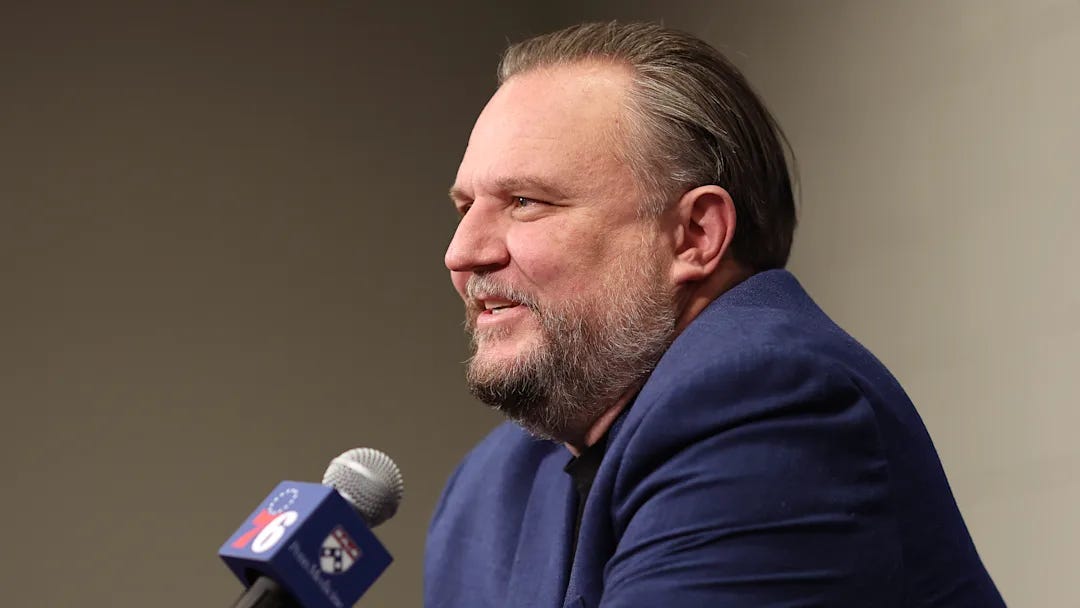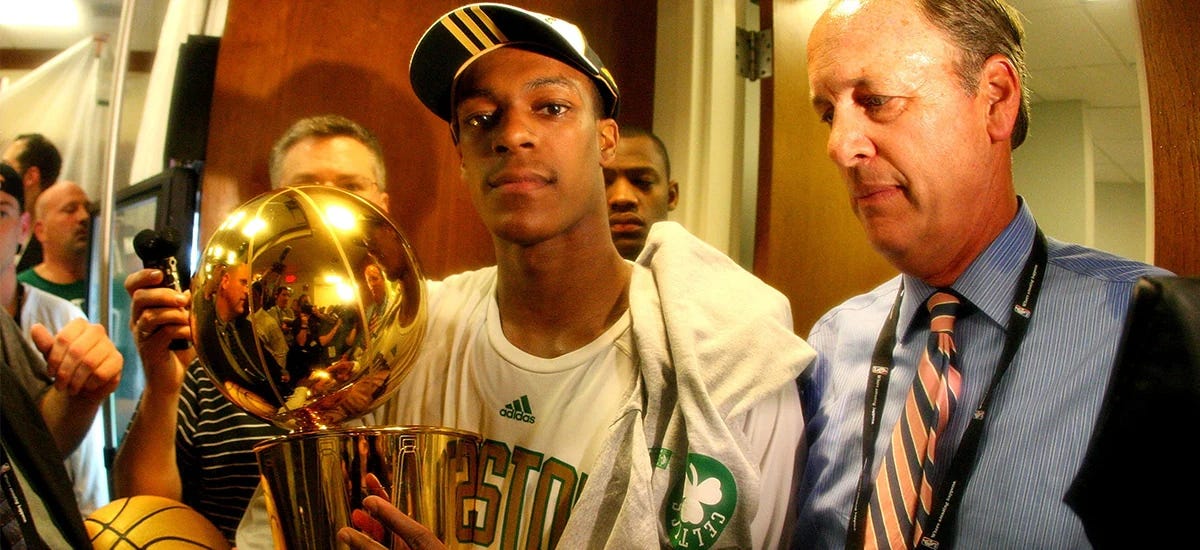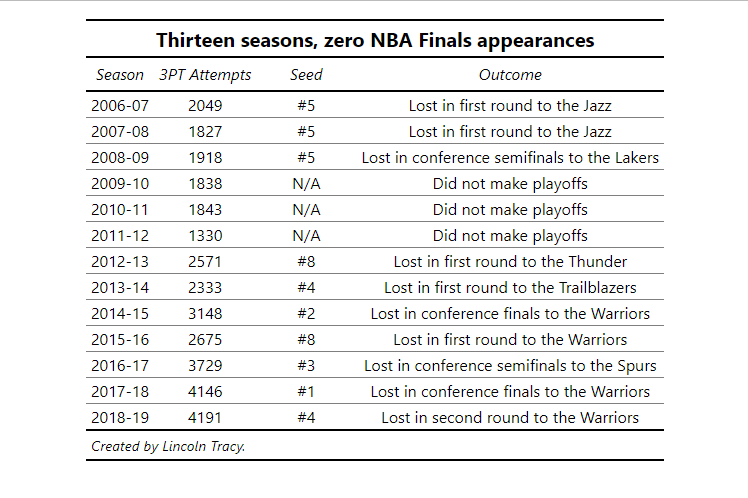Forget Moneyball, we’re playing Moreyball
It’s not enough just to put up a lot of three-pointers, you’ve got to make them count.
Daryl Morey. IMAGE: Tim Nwachukwu/GettyImages
Earlier this year I read Bruce Schoenfeld’s Game of Edges, which explores how advances in technology and data capture/analysis has changed how professional sports teams play the game and are run.
These improvements have largely been driven by a group of younger franchise owners with a greater understanding on how data can be used to win more championships and engage more fans.
One storyline through the book I found interesting was that of Daryl Morey, the statistical analyst turned basketball executive. Morey, who grew up in Cleveland, graduated from Northwestern with a degree in computer science before going on to complete a business degree at MIT.
After college he worked as a statistical analyst and consultant before starting his executive career with the Boston Celtics in 2002 (senior vice president of operations), before moving to the Houston Rockets in 2006 to serve as the team’s assistant general manager. He was elevated to general manager of the Rockets in 2007 and is currently the president of basketball operations at the Philadelphia 76ers.
During his time at the Celtics, Morey dedicated a substantial amount of time trying to identify what metrics at the college level were the best predictors of future success. His efforts helped guide the Celtics drafting Rajon Rondo in 2006, despite Rondo not having an overly impressive college career.
However, Rondo had the characteristics Morey valued in a point guard at the time – the ability to put up a high number of rebounds and free throw attempts – and went on to cement a spot in the starting line up during the 2007-08 season, when the Celtics won their seventeenth Championship.
But perhaps Morey’s biggest impact on the game comes from his time at the Rockets, where he placed a real emphasis on parts of the game that others didn’t necessarily appreciate, like three-point shooting and defensive skills.
As Schoenfeld explains:
“Morey innately understood the wisdom in taking as many of those shots as possible. (You don’t need an MIT degree to figure out the math: you get three points for each shot you make, rather than two.)
“Rather than trying to work the ball inside for an easy jumper, lay-up, or dunk, he wanted his players to look for those slightly harder shots that were worth 50 percent more if they went in.”
During the 2005-06 NBA season, prior to Morey starting as an assistant general manager, the Rockets attempted an average of 17.2 three-point attempts per game, slightly higher than the league average of 15.8 attempts per game.
The number of three-point attempts the Rockets put up increased dramatically over the next 13 seasons, even if it took a few years for things to really take off.
The 2017-18 season saw the Rockets become the first team in the NBA’s history to attempt more three-pointers than two-pointers over the course of the regular season (3470 versus 3436). Houston repeated this feat in 2018-19 (3721 versus 3442) and 2019-20 (3261 versus 3251).
By the time Morey left the organisation following the 2019-20 season, the team were attempting more than 45 three-pointers each game.
It wasn’t all smooth sailing, however. The Rockets made the playoffs in Morey’s first three seasons with the team but failed to quality in the following three. Houston made the playoffs for the next seven seasons, falling short of the NBA Finals – and their first Championship since going back-to-back during the 1993-94 and 1994-95 seasons – each time.
As Schoenfeld points out:
“Another team understood Morey’s insights, and was in the process of doing an even better job of applying them. For four of the five seasons between 2014-15 and 2018-19, the Rockets lost to the Golden State Warriors in the playoffs.”
“Not coincidentally, the Warriors happened to have Steph Curry, who won consecutive Most Valuable Player awards largely by launching 10 or 11 three-pointers every game with an almost imperceptibly quick flick of his hands, making nearly half of them.”
Schoenfeld’s last point about Curry’s accuracy when it comes to three-point shooting emphasises his point about the Warriors beating Morey and the Rockets at their own game. Houston attempted more three-pointers than Golden State in four of the five seasons and made more shots as a result of having more attempts – but also missed a lot more than their opponents, as seen in the graph below.
The difference in three-point shooting percentage between the two teams made even more visible when only you only consider the games they played against each other. While Houston and Golden State attempted a similar number of three-point field goals in the 2014-15 and 2015-16 seasons – with the Warriors actually attempting more during the clashes in the 2016-17 season – the west coast team were normally more consistent at making shots.
The only real exception to the trend was the 2018-19 playoffs, where the Rockets shot at 36.7% compared to the Warriors’ 34.7%. The series (4-2 to Golden State) was closely contested, with all six games decided by six or fewer points – a first in NBA playoff history.
Morey moved to the Philadelphia 76ers ahead of the 2020-21 season but is still searching for that elusive championship. Under Morey’s tenure the 76ers have finished each season as a top three seed but have failed to progress past the Conference semi-finals.
Perhaps the plan to keep All-Star centre Joel Embiid healthy by having him play few, if any, back-to-back games may be the difference for Morey this season.
The timeframe of this stat is limited based on what data are freely/easily available and/or accessible. Please don’t hesitate to contact me if you spot any errors in what I have presented.









